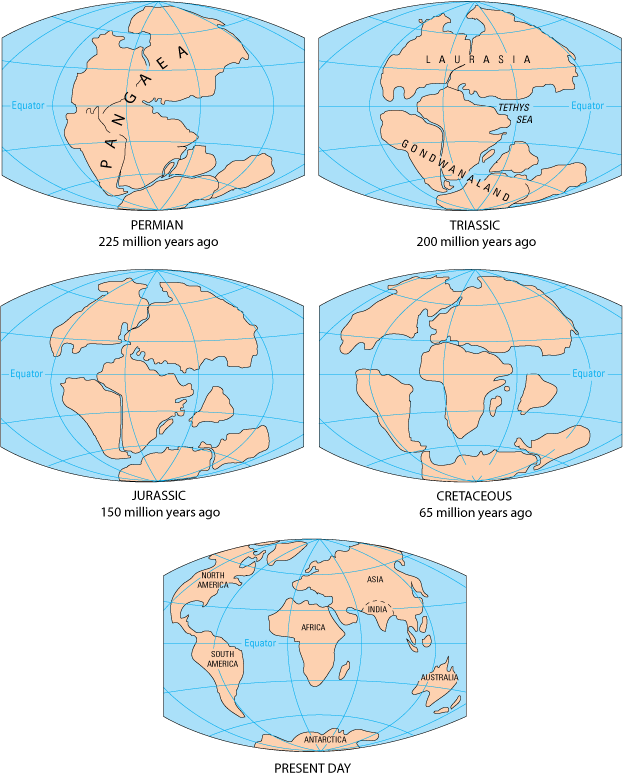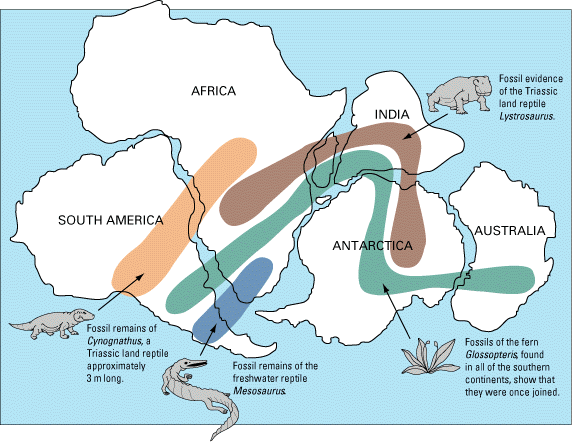EXPLORE: Continental Drift (BrainPop)
| Site: | Mountain Heights Academy OER |
| Course: | Earth Science Q2 |
| Book: | EXPLORE: Continental Drift (BrainPop) |
| Printed by: | Guest user |
| Date: | Thursday, 24 July 2025, 9:05 PM |
Description
Continental drift, Wegener, and Pangaea
1. VIEW: Pangaea (BrainPop)

Map courtesy of USGS. Image is in the public domain.
According to the theory of continental drift, Pangaea began to break apart approximately 225 million years ago. About 200 million years ago, Pangaea separated into two large continents: Laurasia and Gondwanaland. Laurasia comprises the northern hemisphere part of Pangaea, and includes most of present-day Europe, North America, Greenland, and Asia. Gondwanaland comprises the southern hemisphere of Pangaea, and includes most of present-day South America, Africa, Antarctica, Australia, and India. Between 150 - 65 million years ago, the continents as we know them today began to separate from one another and drifted to their current locations.
2. READ: Evidence for Continental Drift

Map courtesy of USGS. Image is in the public domain
Wegener had many pieces of evidence to support his assertion that the continents had broken apart and drifted to their modern locations. For one, the shapes of the continents match like puzzle pieces. This is especially true of the coastlines of South America and Africa. Wegener also collected rock, fossil, and climate evidence to support his theory of continental drift.
Rock Evidence
When Wegener reassembled the continents, he noticed that now-separated plates had similar mountain ranges and rock types. For example, the Appalachian Mountains on the eastern side of the North American plate were structurally and compositionally similar to mountains in Europe and Greenland. He made similar observations of the rock types in western Africa and eastern South America.
Fossil Evidence
Wegener also noticed that similar fossils of plant and animals were found in rocks of the same age on continents that are separated today. Fossils of Glossopteris were found spread across Antarctica, South America, Africa, Australia and India. Fossils of the land-dwelling reptiles Cynognathus and Mesosaurus were found on both Africa and South America, while fossils of Lystrosaurus were found on Antarctica, India, and Africa. Wegener reasoned that these land-dwelling animals could not have swum the great distances that exist between the continents today; therefore, the continents must have been connected when these animals lived on Earth.
Climate Evidence
In Wegener's mind, the drifting of continents after the break-up of Pangaea explained not only the matching fossil occurrences but also the evidence of dramatic climate changes on some continents. For example, the discovery of fossils of tropical plants (in the form of coal deposits) in Antarctica led to the conclusion that this frozen land previously must have been situated closer to the equator, in a more tropical climate where lush, swampy vegetation could grow.
Additionally, coal deposits found today in Europe and North America were created from plants that grew and decayed in tropical swamps about 300 million years ago. Therefore, these continents must have once been located much closer to the equator in Earth's geologic past. Other mismatches of geology and climate included distinctive fossil ferns (Glossopteris) discovered in now-polar regions and the occurrence of glacial deposits in present-day arid Africa, such as the Vaal River valley of South Africa.
Sources
http://pubs.usgs.gov/gip/dynamic/historical.html (public domain)
http://openlearn.open.ac.uk/mod/resource/view.php?id=172173&direct=1 (CC BY-NC-SA)
3. EXPLORE: Evidence for Pangaea
Early scientists found fossil evidence of plants and animals existing in places where they couldn't possibly survive given the climatic conditions of the day. For example, dinosaurs seemed like a poor fit for life on Antarctica, yet their remains were found there. They also found that continents on opposite sides of the world shared many common species.
The theory of continental drift (and the later theory of plate tectonics) revolutionized the fields of geology and biology. Alfred Wegener compared fossilized plant and animals & rock types and the patterns he observed (such as the existence of the same rocks and fossils on opposite sides of the Atlantic Ocean) supported his theory that the continents were once all connected. Wegener could not explain how the continents drifted, but his ideas laid the foundation for the theory of plate tectonics.
4. READ: Problems with Continental Drift

Though he had many lines of evidence to support his idea, there was one flaw that caused most scientists to reject the theory of continental drift: he could not explain how the continents moved. When calculations were made to determine the size of force one would need to move a continent, it became clear that Wegener’s idea was not possible. The force needed to move a continent across thousands of miles of ocean floor so large that it would fracture the continent and it would not remain as a single landmass. If such a process had indeed happened, the shapes of the two continents would be vastly different from one another, having been broken, rearranged, and altered to a large degree by the gargantuan force. Thus, the similarity of the shape of the South American and African coastlines was simply a coincidence. If the two had moved 3000 miles apart, as Wegener proposed, they surely would have been broken into a zillion pieces by the very forces that were to move them. Wegener’s theory was simply unworkable; the geophysics did not support his assertions.
The process of scientific inquiry is one where a simple and seemingly well-supported idea can be brought to naught by a single piece of contradictory evidence. Wegener could not explain how the continents could be moved thousands of miles and still retain their matching shapes. This inability to explain the forces which would move the continents caused the scientific community to dismiss Wegener’s continental drift theory.
Undaunted by rejection, Wegener devoted the rest of his life to doggedly pursuing additional evidence to defend his theory. He froze to death in 1930 during an expedition crossing the Greenland ice cap, but the controversy he spawned raged on.
Source:http://pubs.usgs.gov/gip/dynamic/historical.html (public domain)